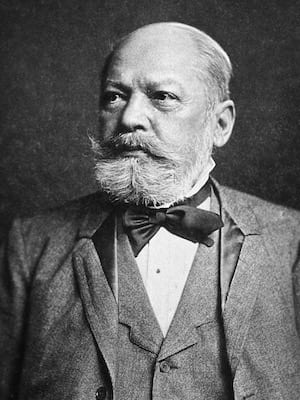Carl Gerhardt

Carl Jakob Adolf Christian Gerhardt (1833-1902) was a German physician.
Carl Jakob Adolf Christian Gerhardt (1833–1902) was a German internist and influential clinical educator whose name remains associated with pioneering diagnostic methods and the early institutionalization of paediatrics. A product of the Würzburg medical school, Gerhardt developed a lifelong interest in natural sciences, clinical medicine, and public health, rising to hold prestigious posts at Jena, Würzburg, and ultimately Berlin’s Charité Hospital.
Gerhardt’s most enduring legacy lies in the formal development of paediatrics as an independent medical discipline. As editor of the seminal Handbuch der Kinderkrankheiten (1877–1896), he synthesized clinical insights into a structured paediatric framework, helping legitimize and standardize child health care in the German-speaking world. The work became a foundational text, undergoing multiple editions and influencing subsequent generations of paediatricians, including Theodor Escherich (1857–1911).
Beyond paediatrics, Gerhardt was a renowned diagnostician who advanced the integration of physical and chemical methods into routine internal medicine. He introduced the iron chloride test (Gerhardt’s reaction) for detecting ketone bodies in urine—pivotal in the diagnosis of diabetic ketoacidosis. He also detailed several conditions now eponymously linked to him, including Gerhardt’s sign and Gerhardt’s law, and made early observations on erythromelalgia, then referred to as Gerhardt’s disease.
As a teacher and reformer, Gerhardt modernized clinical education, promoted laryngoscopy, emphasized empirical bedside methods, and advocated for hygienic reforms in tuberculosis care. His service as rector of both Jena and Berlin universities and his election to the Leopoldina in 1886 reflected his standing among peers. With a distinguished international consultancy and a lineage of prominent students, Gerhardt shaped the contours of clinical medicine in late 19th-century Europe.
Biography
- 1833 – Born May 5 in Speyer, Germany.
- 1850–1856 – Studied medicine at the University of Würzburg; mentored by Heinrich von Bamberger, Joseph Johann von Scherer, Franz von Rinecker, and Albert von Kölliker.
- 1856 – Awarded doctorate in medicine; appointed assistant at the Würzburg medical polyclinic.
- 1858–1860 – Assistant physician and private lecturer in Tübingen under Wilhelm Griesinger (1817–1868).
- 1860 – Returned to Würzburg and completed habilitation.
- 1861–1862 – Appointed professor and director of the medical clinic at the University of Jena.
- 1867 – Served as rector of the University of Jena.
- 1872 – Returned to Würzburg as professor and director of the medical clinic at the Juliusspital.
- 1885 – Appointed professor of internal medicine and director of the second medical clinic at the Charité in Berlin, succeeding Friedrich Theodor von Frerichs (1819–1885).
- 1888–1889 – Served as rector of Friedrich-Wilhelms-Universität, Berlin.
- 1902 – Died July 21/22 in Gamburg bei Mosbach
Medical Eponyms
Gerhardt Law (1863)
Describes the vocal cord position in bilateral recurrent laryngeal nerve paralysis: the cords assume a paramedian position, intermediate between full abduction and adduction.
This clinical sign aids in diagnosing laryngeal nerve injury, particularly in progressive neurological or postoperative contexts.
First detailed in Gerhardt’s studies on vocal cord paralysis in Studien und Beobachtungen über Stimmbandlähmung, 1863
Gerhardt sign (1882)
Systolic pulsation of the spleen observed in patients with aortic insufficiency. This phenomenon results from transmitted pulse pressure and is particularly evident when the spleen is enlarged.
The pulsating spleen was first described by Nicholaes Tulpii in 1641 as ‘lien verberans‘ , without a defined cause.
Carl Gerhardt presented three cases of patients with aortic insufficiency and concomitant fever. Gerhardt regarded the pulsatile spleen as a characteristic sign caused by the abnormal blood-pressure conditions of aortic insufficiency with the relaxation of the blood vessels produced by the fever.
Entsteht bei Kranken mit Insufficienz der Aortenklappen ein tastbarer Milztumor, so kann man pulsatorische Bewegungen daran wahrnehmen.
If a palpable splenomegaly develops in patients with insufficiency of the aortic valves, it is possible to perceive pulsatile movements
Gerhardt reaction (1865)
A diagnostic test using ferric chloride to detect acetoacetic acid in the urine of diabetic patients. The presence of ketone bodies was indicated by a red or burgundy coloration upon addition of the reagent. Though historically important in recognizing diabetic ketoacidosis, the test is now obsolete due to limited sensitivity and specificity.
Major Publications
- Gerhardt C. Der Kehlkopfscroup. 1859
- Gerhardt C. Studien und Beobachtungen über Stimmbandlähmung. Archiv für pathologische Anatomie und Physiologie und für klinische Medicin. 1863; 27: 68-78, 296-321
- Gerhardt C. Diabetes mellitus und Aceton. Wiener medizinische Presse, 1865, 6: 672. [Gerhardt reaction]
- Gerhardt C. Lehrbuch der Kinderkrankheiten. 1861 (2e 1874, 3e 1877, 4e 1881, 5e 1897)
- Gerhardt C. Pulsirender Miltztumor. Zeitschrift für klinische Medizin, 1882; 4: 449-450 [Gerhardt sign]
- Gerhardt C. Palpation des Unterleibes. In: Lehrbuch der Auscultation und Percussion. 1883: 85-92 [Gerhardt sign]
References
Biography
- Stürzbecher M. Gerhardt, Carl Jakob Christian Adolph. Neue Deutsche Biographie 1964; 6: 284
- Karl Adolf Christian Jakob Gerhardt. Humboldt-Universität zu Berlin
- Karl Adolf Christian Jakob Gerhardt. wuerzburgwiki
Eponymous terms
- Zhang G. Eponyms in Aortic Regurgitation. LITFL 2019
- Gerhardt, Carl Jakob Christian Adolf. German Biography 2019
- Sebastian A. A Dictionary of the History of Medicine. Routledge. 2018.
Eponym
the person behind the name
BA MA (Oxon) MBChB (Edin) FACEM FFSEM. Emergency physician, Sir Charles Gairdner Hospital. Passion for rugby; medical history; medical education; and asynchronous learning #FOAMed evangelist. Co-founder and CTO of Life in the Fast lane | On Call: Principles and Protocol 4e| Eponyms | Books |
